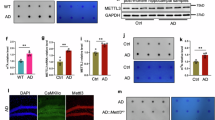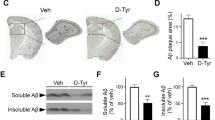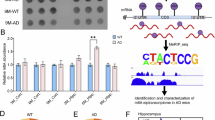Abstract
Alzheimer’s disease (AD), a leading cause of dementia, represents a critical unmet global medical need. While the precise mechanisms underlying AD pathogenesis remain elusive, increasing evidence underscores the pivotal role of neuroinflammation in driving cognitive impairment. N6-methyladenosine (m6A), an epigenetic modification regulating RNA metabolism, has been found to be dysregulated in AD. In this study, we used a Mettl14 conditional knockout APP/PS1 mouse model (AD-cKO mice) to investigate the effects of modulating astrocytic m6A levels on AD progression. Our comprehensive histological, biochemical, and transcriptomic analyses revealed that AD-cKO mice exhibited enhanced cognitive function, along with decreased astrogliosis and reduced neuroinflammation when compared to APP/PS1 control mice. Based on the conjoint analysis of MeRIP-seq and RNA-seq data, our mechanistic studies further demonstrated that the loss of Mettl14 in astrocytes significantly affected the expression of DUSP1, a negative regulator of inflammation, to mitigate MAPK signaling. These findings suggest that targeting m6A regulators, such as Mettl14, may represent a promising therapeutic strategy to control neuroinflammation in AD progression. This study also highlights the broader potential of epigenetic modulation as a novel approach for treating AD.

This graphic abstract illustrates the impact of Mettl14-mediated m6A modification on Alzheimer’s disease (AD) pathogenesis. Alzheimer’s disease, a leading cause of dementia, involves significant neuroinflammation. The study utilizes a Mettl14 conditional knockout APP/PS1 mouse model (AD-cKO mice) to investigate the role of m6A modification in astrocytes, the findings suggest that targeting m6A regulators like Mettl14 offers potential therapeutic benefits for controlling neuroinflammation in AD.
This is a preview of subscription content, access via your institution
Access options
Subscribe to this journal
Receive 12 print issues and online access
$259.00 per year
only $21.58 per issue
Buy this article
- Purchase on SpringerLink
- Instant access to full article PDF
Prices may be subject to local taxes which are calculated during checkout






Similar content being viewed by others
Data availability
The data that support the findings of this study are available from the corresponding author YL, upon request. The raw MeRIP-Seq data is available on Dryad at https://doi.org/10.5061/dryad.pc866t217.
References
Scheltens P, De Strooper B, Kivipelto M, Holstege H, Chetelat G, Teunissen CE, et al. Alzheimer’s disease. Lancet. 2021;397:1577–90.
Calsolaro V, Edison P. Neuroinflammation in Alzheimer’s disease: current evidence and future directions. Alzheimers Dement. 2016;12:719–32.
Murphy MP, LeVine H 3rd. Alzheimer’s disease and the amyloid-beta peptide. J Alzheimers Dis. 2010;19:311–23.
Lee VM, Goedert M, Trojanowski JQ. Neurodegenerative tauopathies. Annu Rev Neurosci. 2001;24:1121–59.
Zhao BS, Roundtree IA, He C. Post-transcriptional gene regulation by mRNA modifications. Nat Rev Mol Cell Biol. 2017;18:31–42.
Shi H, Wei J, He C. Where, when, and how: context-dependent functions of RNA methylation writers, readers, and erasers. Mol Cell. 2019;74:640–50.
Fan Y, Lv X, Chen Z, Peng Y, Zhang M. m6A methylation: critical roles in aging and neurological diseases. Front Mol Neurosci. 2023;16:1102147.
Huang H, Camats-Perna J, Medeiros R, Anggono V, Widagdo J. Altered expression of the m6A methyltransferase METTL3 in Alzheimer’s disease. eNeuro. 2020;7:ENEURO.0125-20.2020.
Zhang R, Zhang Y, Guo F, Li S, Cui H. RNA N6-methyladenosine modifications and its roles in Alzheimer’s disease. Front Cell Neurosci. 2022;16:820378.
Liu Z, Xia Q, Zhao X, Zheng F, Xiao J, Ge F, et al. The landscape of m6A regulators in multiple brain regions of Alzheimer’s disease. Mol Neurobiol. 2023;60:5184–98.
Shafik AM, Zhang F, Guo Z, Dai Q, Pajdzik K, Li Y, et al. N6-methyladenosine dynamics in neurodevelopment and aging, and its potential role in Alzheimer’s disease. Genome Biol. 2021;22:17.
Zhao F, Xu Y, Gao S, Qin L, Austria Q, Siedlak SL, et al. METTL3-dependent RNA m(6)A dysregulation contributes to neurodegeneration in Alzheimer’s disease through aberrant cell cycle events. Mol Neurodegener. 2021;16:70.
Yin H, Ju Z, Zheng M, Zhang X, Zuo W, Wang Y, et al. Loss of the m6A methyltransferase METTL3 in monocyte-derived macrophages ameliorates Alzheimer’s disease pathology in mice. PLoS Biol. 2023;21:e3002017.
Endo F, Kasai A, Soto JS, Yu X, Qu Z, Hashimoto H, et al. Molecular basis of astrocyte diversity and morphology across the CNS in health and disease. Science. 2022;378:eadc9020.
Sofroniew MV. Astrocyte reactivity: subtypes, states, and functions in CNS innate immunity. Trends Immunol. 2020;41:758–70.
Bellaver B, Povala G, Ferreira PCL, Ferrari-Souza JP, Leffa DT, Lussier FZ, et al. Astrocyte reactivity influences amyloid-beta effects on tau pathology in preclinical Alzheimer’s disease. Nat Med. 2023;29:1775–81.
Habib N, McCabe C, Medina S, Varshavsky M, Kitsberg D, Dvir-Szternfeld R, et al. Disease-associated astrocytes in Alzheimer’s disease and aging. Nat Neurosci. 2020;23:701–6.
Chen JJ, Lu TZ, Wang T, Yan WH, Zhong FY, Qu XH, et al. The m6A reader HNRNPC promotes glioma progression by enhancing the stability of IRAK1 mRNA through the MAPK pathway. Cell Death Dis. 2024;15:390.
Zhang S, Zhao BS, Zhou A, Lin K, Zheng S, Lu Z, et al. m(6)A demethylase ALKBH5 maintains tumorigenicity of glioblastoma stem-like cells by sustaining FOXM1 expression and cell proliferation program. Cancer Cell. 2017;31:591–606.e6
Shao W, Zhao H, Zhang S, Ding Q, Guo Y, Hou K, et al. A pan-cancer landscape of IGF2BPs and their association with prognosis, stemness and tumor immune microenvironment. Front Oncol. 2022;12:1049183.
Guo F, Fan J, Liu JM, Kong PL, Ren J, Mo JW, et al. Astrocytic ALKBH5 in stress response contributes to depressive-like behaviors in mice. Nat Commun. 2024;15:4347.
Huang R, Zhang Y, Bai Y, Han B, Ju M, Chen B, et al. N(6)-methyladenosine modification of fatty acid amide hydrolase messenger RNA in circular RNA STAG1-regulated astrocyte dysfunction and depressive-like behaviors. Biol Psychiatry. 2020;88:392–404.
Teng Y, Liu Z, Chen X, Liu Y, Geng F, Le W, et al. Conditional deficiency of m6A methyltransferase Mettl14 in substantia nigra alters dopaminergic neuron function. J Cell Mol Med. 2021;25:8567–72.
Neal ML, Boyle AM, Budge KM, Safadi FF, Richardson JR. The glycoprotein GPNMB attenuates astrocyte inflammatory responses through the CD44 receptor. J Neuroinflammation. 2018;15:73.
Kober C, Rohn S, Weibel S, Geissinger U, Chen NG, Szalay AA. Microglia and astrocytes attenuate the replication of the oncolytic vaccinia virus LIVP 1.1.1 in murine GL261 gliomas by acting as vaccinia virus traps. J Transl Med. 2015;13:216.
Zhang Z, Wang M, Xie D, Huang Z, Zhang L, Yang Y, et al. METTL3-mediated N(6)-methyladenosine mRNA modification enhances long-term memory consolidation. Cell Res. 2018;28:1050–61.
Stanca S, Rossetti M, Bongioanni P. Astrocytes as neuroimmunocytes in Alzheimer’s disease: a biochemical tool in the neuron-glia crosstalk along the pathogenetic pathways. Int J Mol Sci. 2023;24:13880.
Jiang L, Roberts R, Wong M, Zhang L, Webber CJ, Kilci A, et al. Accumulation of m6A exhibits stronger correlation with MAPT than β-amyloid pathology in an APPNL-G-F /MAPTP301S mouse model of Alzheimer's disease. Preprint. bioRxiv (2023) https://doi.org/10.1101/2023.03.28.534515.
Ge X, Ye W, Zhu Y, Cui M, Zhou J, Xiao C, et al. USP1/UAF1-stabilized METTL3 promotes reactive astrogliosis and improves functional recovery after spinal cord injury through m(6)A modification of YAP1 mRNA. J Neurosci. 2023;43:1456–74.
Wang B, Liu Y, Jiang R, Liu Z, Gao H, Chen F, et al. Emodin relieves the inflammation and pyroptosis of lipopolysaccharide-treated 1321N1 cells by regulating methyltransferase-like 3 -mediated NLR family pyrin domain containing 3 expression. Bioengineered. 2022;13:6740–9.
Shen XN, Huang SY, Cui M, Zhao QH, Guo Y, Huang YY, et al. Plasma glial fibrillary acidic protein in the alzheimer disease continuum: relationship to other biomarkers, differential diagnosis, and prediction of clinical progression. Clin Chem. 2023;69:411–21.
Chen Z, Balachandran YL, Chong WP, Chan KWY. Roles of cytokines in Alzheimer’s disease. Int J Mol Sci. 2024;25:5803.
Liddelow SA, Guttenplan KA, Clarke LE, Bennett FC, Bohlen CJ, Schirmer L, et al. Neurotoxic reactive astrocytes are induced by activated microglia. Nature. 2017;541:481–7.
Escartin C, Galea E, Lakatos A, O’Callaghan JP, Petzold GC, Serrano-Pozo A, et al. Reactive astrocyte nomenclature, definitions, and future directions. Nat Neurosci. 2021;24:312–25.
Li Y, Li J, Yu Q, Ji L, Peng B. METTL14 regulates microglia/macrophage polarization and NLRP3 inflammasome activation after ischemic stroke by the KAT3B-STING axis. Neurobiol Dis. 2023;185:106253.
Shi Q, Chowdhury S, Ma R, Le KX, Hong S, Caldarone BJ, et al. Complement C3 deficiency protects against neurodegeneration in aged plaque-rich APP/PS1 mice. Sci Transl Med. 2017;9:eaaf6295.
Lian H, Yang L, Cole A, Sun L, Chiang AC, Fowler SW, et al. NFkappaB-activated astroglial release of complement C3 compromises neuronal morphology and function associated with Alzheimer’s disease. Neuron. 2015;85:101–15.
Keyse SM. Protein phosphatases and the regulation of mitogen-activated protein kinase signalling. Curr Opin Cell Biol. 2000;12:186–92.
Collins LM, Downer EJ, Toulouse A, Nolan YM. Mitogen-activated protein kinase phosphatase (MKP)-1 in nervous system development and disease. Mol Neurobiol. 2015;51:1158–67.
Arango-Lievano M, Peguet C, Catteau M, Parmentier ML, Wu S, Chao MV, et al. Deletion of neurotrophin signaling through the glucocorticoid receptor pathway causes tau neuropathology. Sci Rep. 2016;6:37231.
Li J, Wang L, Zeng Q, He J, Tang Q, Wang K, et al. MKP-1 regulates the inflammatory activation of microglia against Alzheimer’s disease. CNS Neurosci Ther. 2024;30:e14409.
Du Y, Du Y, Zhang Y, Huang Z, Fu M, Li J, et al. MKP-1 reduces Abeta generation and alleviates cognitive impairments in Alzheimer’s disease models. Signal Transduct Target Ther. 2019;4:58.
Feng J, Meng W, Chen L, Zhang X, Markazi A, Yuan W, et al. N(6)-methyladenosine and reader protein YTHDF2 enhance the innate immune response by mediating DUSP1 mRNA degradation and activating mitogen-activated protein kinases during bacterial and viral infections. mBio. 2023;14:e0334922.
Dhapola R, Hota SS, Sarma P, Bhattacharyya A, Medhi B, Reddy DH. Recent advances in molecular pathways and therapeutic implications targeting neuroinflammation for Alzheimer’s disease. Inflammopharmacology. 2021;29:1669–81.
Saha P, Guha S, Biswas SC. P38K and JNK pathways are induced by amyloid-beta in astrocyte: implication of MAPK pathways in astrogliosis in Alzheimer’s disease. Mol Cell Neurosci. 2020;108:103551.
Kim E, Kim H, Jedrychowski MP, Bakiasi G, Park J, Kruskop J, et al. Irisin reduces amyloid-beta by inducing the release of neprilysin from astrocytes following downregulation of ERK-STAT3 signaling. Neuron. 2023;111:3619–33.e8
Son SH, Lee NR, Gee MS, Song CW, Lee SJ, Lee SK, et al. Chemical knockdown of phosphorylated p38 mitogen-activated protein kinase (MAPK) as a novel approach for the treatment of Alzheimer’s disease. ACS Cent Sci. 2023;9:417–26.
Dou X, Huang L, Xiao Y, Liu C, Li Y, Zhang X, et al. METTL14 is a chromatin regulator independent of its RNA N6-methyladenosine methyltransferase activity. Protein Cell. 2023;14:683–97.
Acknowledgements
The authors would like to thank Dr. Li Hua-bing (Shanghai Institute of Immunology, State Key Laboratory of Oncogenes and Related Genes, School of Medicine, Shanghai Jiao Tong University) for his support in providing the Mettl14-loxp mice.
Author information
Authors and Affiliations
Contributions
YL conceptualized the project. YL and TY contributed to experimental design and data interpretation. TY, XJL, and HS performed experiments and analyzed data with the assistance of YJ, LMJ, TQ, CXM, WF and LYZ. YL wrote the manuscript with input from all the authors. XY, ZJL and YJ helped with the discussion, YL, ZM and LWD supervised the project, provided resources, and acquired funds.
Corresponding authors
Ethics declarations
Competing interests
The authors declare no competing interests.
Ethics approval and consent to participate
All methods in this study were performed in accordance with the relevant guidelines and regulations. Ethical approval was obtained from the the Ethics Committee of University of Electronic Science and Technology of China. Informed consent was obtained from all participants involved in this study.
Additional information
Publisher’s note Springer Nature remains neutral with regard to jurisdictional claims in published maps and institutional affiliations.
Supplementary information
Rights and permissions
Springer Nature or its licensor (e.g. a society or other partner) holds exclusive rights to this article under a publishing agreement with the author(s) or other rightsholder(s); author self-archiving of the accepted manuscript version of this article is solely governed by the terms of such publishing agreement and applicable law.
About this article
Cite this article
Teng, Y., Xu, J., He, S. et al. Astrocytic Mettl14 depletion enhances cognitive function by attenuating astrogliosis via the DUSP1/MAPK pathway in APP/PS1 mice: targeting neuroinflammation in Alzheimer’s disease. Mol Psychiatry (2025). https://doi.org/10.1038/s41380-025-03211-w
Received:
Revised:
Accepted:
Published:
DOI: https://doi.org/10.1038/s41380-025-03211-w



